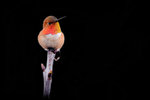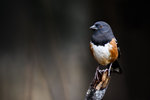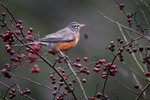


Editors Note: This article was originally published April 6, 2022. One year of enjoying learning about Thurston County's feathered wonders.
Knowing I’m interested in birds, people occasionally ask me to advise them on how to get started in bird watching. And I usually answer, “just walk around your neighborhood and pay attention.” And that’s exactly what I did to gain inspiration for this initial column.
April is a great month to start the bird watching hobby, or to just renew a long dormant interest. During my walk this afternoon I encountered the usual suspects. First on any neighborhood list at this time of year is the American Robin. They’re frequently seen on the grass and are very noisy, always making their loud musical chirps. Sometimes, the males may break out their musical song, especially in the early morning. It won’t be long until they pair up and begin nesting.
Also prominent on most neighborhood lists is the Song Sparrow. They like to hang out in clumps of bushes, skulking around and, at this time of year, bursting out with at least a segment of their typical song. Want to impress your friends when they ask, “what’s that little brown bird?” Just answer that it’s a Song Sparrow and most of the time you’ll be right.
I don’t always hear a chickadee on my walk, but I did today. They frequent one of the feeders in our area and often call out “chick-a-dee-dee.” The most common species in our area is the Black-capped Chickadee; they look quite handsome with contrasting white cheeks and black cap.
For all the birds I have mentioned so far, the males and females look more or less alike. (Presumably they can tell the difference, but we bird watchers usually cannot). For other bird species I encountered today, the sexes differ in appearance. One interesting local bird is the Spotted Towhee. The male Towhee is black with orange sides, a white belly, spots on the wings and a bright red iris. Females, in contrast, are a drab brown. Towhees have an interesting call that sounds a little like a mewing cat. They like bushes, too, but sometimes are out and about. As they fly away, notice the white spots on the corners of its black tail. Spotted Towhee, indeed!
Another small neighborhood bird with white tail feathers -- the outer feathers very visible in flight -- is the Oregon Junco (official name, Dark-eyed Junco). These birds hang out all winter in loose flocks, only splitting into pairs this month. They are ground-nesting birds and, once they establish a nest, can be very quiet and secretive. Sometimes people find a junco nest hidden in the tall grass beside a fence post or the like.
Northern Flickers are a type of woodpecker and, unusual for woodpeckers, they often are on the ground (they like eating ants). They are good-sized birds, larger than a robin, and are predominantly brown. They have a nice black crescent mark across their breasts and the sexes have different face markings. When they fly away, a bold white rump patch is a sure give-away for identifying this species. So is its raucous call.
Finally, I want to mention hummingbirds. We have two species: Anna’s, which stay year-round, and Rufous, which returns from its wintering grounds in March. The Rufous male is bright rusty color with an iridescent orange chin patch. The hum of his wings is very noticeable and distinctive. If there is a hummingbird feeder in your neighborhood, then you have local hummers. But this time of year, with all the flowers in bloom and numerous small insects to catch, hummers are not primarily hanging around feeders. Rather, the males are trying to dominate a feeding territory. Almost anytime you see a big clump of blooming salmonberry or red-flowering currant bushes blooming you are likely to hear a hummingbird nearby.
In spring a new species of migratory bird species is arriving each week. In future columns I’ll give you an alert about what has arrived. For this week, we note that several species of swallows have arrived, but they are still hanging out in larger flocks and for the most, have not yet taken up nesting territories.
George Walter is environmental program manager at the Nisqually Indian Tribe’s natural resources department; he also has a 40+ year interest in bird watching. Contact him at george@theJOLTnews.com
Photos for this column are provided by Liam Hutcheson, a 14-year-old Olympia area bird enthusiast and avid photographer.
Comments
No comments on this item Please log in to comment by clicking here